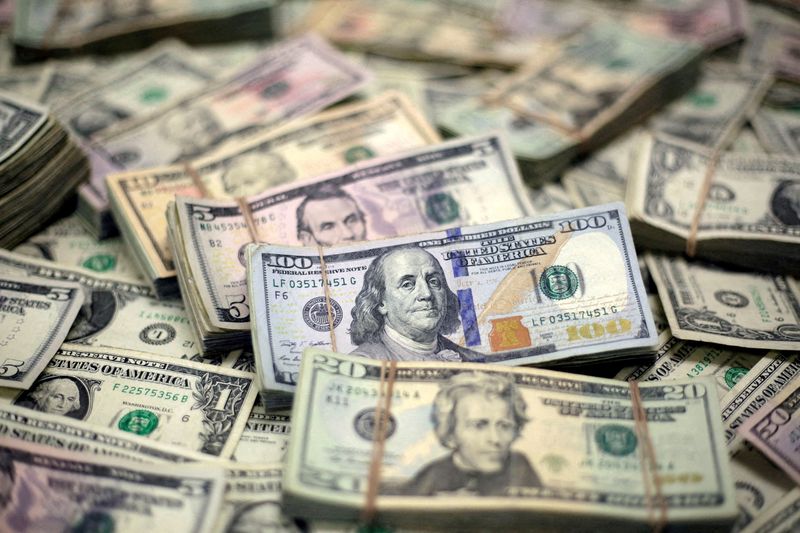Forex
Dollar drops to two-week low as investors take profit on ‘Trump trades’

By Medha Singh and Wayne Cole
(Reuters) -The dollar dipped on Monday as investors braced for wide-ranging implications for the global economy this week from the outcome of U.S. elections and a likely interest rate cut from the Federal Reserve.
The euro jumped 0.7% to $1.0906. The dollar fell nearly 1% on the yen to 151.645. The eased to 103.65, its lowest in two weeks against a basket of currencies.
U.S. Treasury yields dropped 8 basis points (bps), retracing some of Friday’s surge. [US/]
Democratic candidate Kamala Harris and Republican Donald Trump remain almost tied in opinion polls and the winner might not be known for days after voting ends.
Investors in recent weeks increasingly positioned for a Trump win, and expected his policies on immigration, tax cuts and tariffs to put upward pressure on inflation, bond yields and the dollar. Harris is seen as the continuity candidate.
Strategists said the dollar weakness on Monday was linked to a poll that showed Harris with a surprise three-point lead in Iowa. A separate New York Times/Siena College poll showed Harris was marginally ahead in Nevada, North Carolina and Wisconsin and Trump just ahead in Arizona, among the handful of battleground states where the election is most competitive.
“The polls suggesting that Harris may have her nose in front in couple of swing states is causing a bit of profit-taking in the Trump trade,” said Kenneth Broux, head of corporate research FX and rates at Societe Generale (OTC:).
“Markets are very stretched – long dollars, short Treasuries – into the vote tomorrow so it’s only natural we are adjusting some of that positioning.”
Betting site PredictIT showed Harris at 53 cents and Trump on 52 cents – what investors are willing to wager for a chance to win $1 – a turnaround from 45 cents and 59 cents respectively, just a week ago.
“It’s certainly one of the most uncertain U.S. elections compared to recent ones,” said Roberto Mialich currency strategist at UniCredit, referring to positioning in the options market that showed investors were buying protection against wild swings following Tuesday’s vote.
“The risk that we may not have a black and white result as early as Wednesday is adding to the uncertainty.”
The one-week implied volatility options for euro/dollar was at the highest since March 2023.
Reflecting investor anxiety over trade relations, implied volatility for China’s , seen on the frontline of markets’ reaction to the U.S. election, was at a record high, while that for dollar/Mexican peso was at the highest since April 2020, surpassing the previous election cycle.
PRICED FOR 25BP
This week also includes the Fed’s policy meeting when the U.S. central bank is widely expected to cut rates by a standard 25 basis points on Thursday, rather than repeat the outsized half-point easing of its last decision.
Traders see a 98% chance of a quarter point cut to 4.50%-4.75%, and a near 80% probability of a similar sized move in December, according to CME’s FedWatch tool.
“We are pencilling in four more consecutive cuts in the first half of 2025 to a terminal rate of 3.25%-3.5%, but see more uncertainty about both the speed next year and the final destination,” said Goldman Sachs economist Jan Hatzius.
“Both our baseline and probability-weighted forecasts are now a bit more dovish than market pricing.”
The Bank of England also meets Thursday and is expected to cut by 25 basis points, while the Riksbank is seen easing by 50 basis points and the Norges Bank is expected to stay on hold.
The Reserve Bank of Australia holds its meeting on Tuesday and again is expected to hold rates steady.
The BoE’s decision has been complicated by a sharp selloff in gilts following the Labour government’s budget last week, which also dragged the pound lower.

Early Monday, UK bonds stabilised and sterling regained some of its losses to stand at $1.29820. [GB/]
More stimulus is also expected from China’s National People’s Congress, which is meeting from Monday through Friday.

 Forex3 years ago
Forex3 years agoForex Today: the dollar is gaining strength amid gloomy sentiment at the start of the Fed’s week

 Forex3 years ago
Forex3 years agoUnbiased review of Pocket Option broker

 Forex3 years ago
Forex3 years agoDollar to pound sterling exchange rate today: Pound plummeted to its lowest since 1985

 Forex3 years ago
Forex3 years agoHow is the Australian dollar doing today?

 Cryptocurrency3 years ago
Cryptocurrency3 years agoWhat happened in the crypto market – current events today

 World3 years ago
World3 years agoWhy are modern video games an art form?

 Commodities3 years ago
Commodities3 years agoCopper continues to fall in price on expectations of lower demand in China

 Economy3 years ago
Economy3 years agoCrude oil tankers double in price due to EU anti-Russian sanctions





















